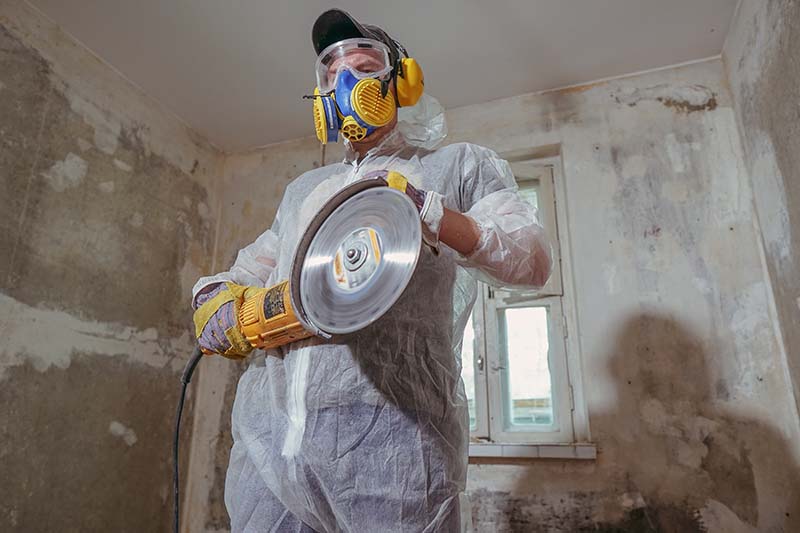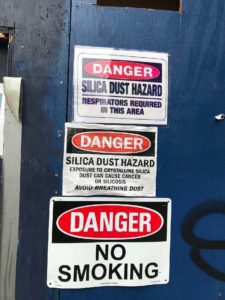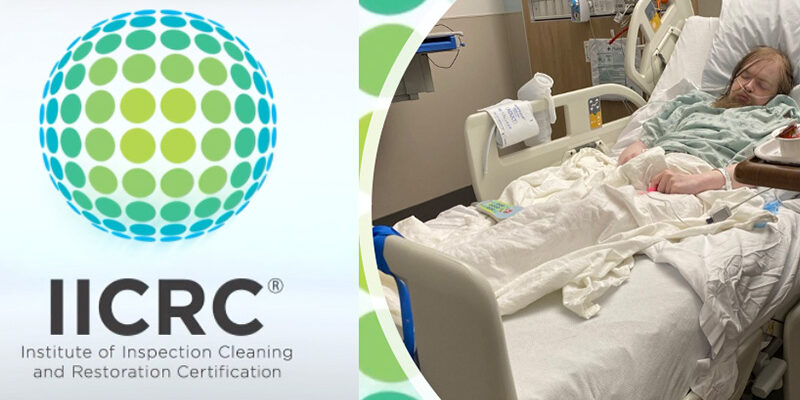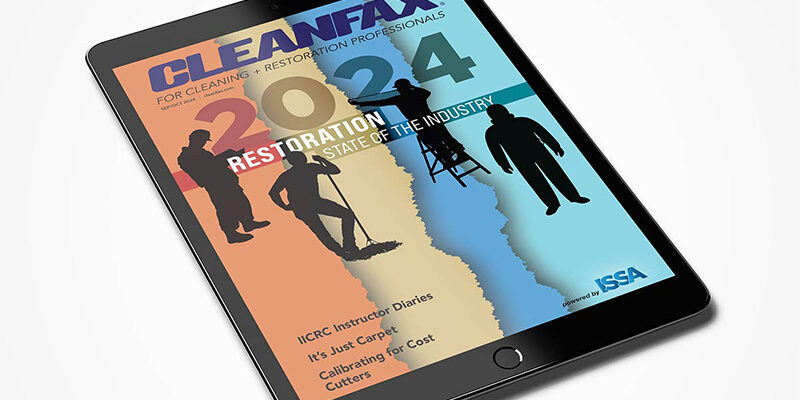The Silica Problem and Restoration Workers

By Mark Drozdov with Amanda Hosey
Silica dust or respirable crystalline silica (RCS) is a danger to most any front-line restoration worker, in addition to millions in other industries, due to silica’s presence in drywall, concrete, brick, mortar, stone, sand, and other common building materials. With asbestos, once we identify materials that contain asbestos, those materials must be handled only by licensed companies and certified personnel. Silica interaction, on the other hand, is not confined to a select few.
However, exposure to silica dust is just as dangerous as exposure to asbestos dust, and in both instances, there is a tremendous risk of being subjected to a cancer-causing dust. Both silica and asbestos are carcinogens. Inhaling RCS particles can cause several diseases including lung cancer, COPD, kidney disease, and, most infamously, silicosis, a deadly lung disease that makes taking in oxygen difficult.
OSHA lowered the permissible exposure limit (PEL) for silica to 50 micrograms (µg) per cubic meter of air in 2016, and before that time, the limit was much higher. Every time restoration workers cut, drill, sand, etc. into silica-containing material, they must be conscious of the potential for exposure and the means to limit their risks.
This article aims to provide restoration companies an overview of the risks associated with silica dust, special implications to the restoration industry, and means to keep workers safe and in compliance with OSHA regulations. This is part of a larger series on P.A.L.M.S. (Look for more articles in this series in upcoming issues.), which is an acronym used to discuss these contaminants of concern:
- PCBs/Pandemic
- Asbestos (March/April 2021 issue)
- Lead/Legionella
- Mold/Metals (Nov/Dec 2021)
- Silica.
Facing the restoration problem
Silica has a direct effect on restoration professionals because everything we touch may have implications concerning silica health hazards and regulatory compliance, specifically when we are cutting drywall (gypsum board, sheetrock, wallboard, etc.), as it contains silica.
In March 2016, OSHA published regulation on silica that specifies how silica-containing materials should be safely handled, providing the “Table 1 Example,” which details silica-related activities that take place on worksites. With this, OSHA provided safe work practices and the required minimal respirative protection for those activities. Table 1 contains the 18 most common worksite activities that put workers at risk of silica exposure, but it, unfortunately, does not include our industry’s biggest concern: drywall. In fairness to OSHA, it is difficult to include every possible task or activity that could take place on the worksite; however, this is obviously a very important one for the restoration industry.
Out of OSHA’s failure to include drywall in Table 1 emerged a question that the restoration industry continues to grapple with: Are the workers involved in restoration work being unnecessarily exposed to silica health hazards? An industry task force that included myself, Lee Senter, and many other restoration industry leaders have been working in an effort to determine what risk, if any, there are for the most frequent activities in the restoration industry. We conducted a pilot test throughout the U.S., with the assistance of IICRC Certified Firms, through which we have monitored workers’ exposure.
We observed the following: Provided the proper work activities, safe work practices, and engineering controls are used, we can alleviate unnecessary exposure to silica dust by the restoration industry in activities related to drywall. Namely the cutting, demolition, or general disturbance of drywall should not occur unless:
- It is properly wetted.
- The use of ventilation, filtration, and HEPA-filtered vacuums are employed.
Prior to the COVID-19 pandemic, we compiled our data and submitted it to OSHA for their review and critique with the request of adding it to Table 1. In June of this year, OSHA responded regarding our study on silica exposure potential and the recommended hazard control measures for the restoration industry, reporting that it was assessing comments and developing the best way forward, with plans to publish a Notice of Proposed Rulemaking on the issue by April 2022.
Adhering to OSHA silica regulation
In Standard 29 CFR 1926.1153, OSHA requires employers to limit worker exposure to RCS and stipulates the 50 µg PEL. To limit exposure, employers must either 1) use proper work practices and engineering controls laid out in Table 1 for other activities to ensure no dust is being generated, in which case no additional PPE would be required, or 2) use appropriate respiratory PPE to protect workers.
Throughout our task force’s pilot testing, we used silica-specific testing to collect air samples around workers’ breathing zones. Those samples were then sent to a certified laboratory that provided silica exposure results. If the result of testing showed more than 50 µg per cubic meter of respirable crystalline silica, then respiratory protection was necessary according to OSHA. If less than the PEL was found, then no respiratory protection was required.
In simple terms, if your work activities do not generate dust above the PEL, no respiratory protection is required by law. But how does one know? And how do you prove compliance to an OSHA inspector?
OSHA first asks, “Did you follow the methods described in Table 1? If workers are drilling through concrete, cutting a cement block, etc. on a jobsite they can easily refer to Table 1, document OSHA requirements were followed, and employ OSHA-required PPE to prove compliance. However, in the case of restoration workers, we cannot simply rely on Table 1 because our most commonly interacted-with silica-containing product, drywall, is not included. In this case, OSHA requires companies to either
- Monitor and do testing like our task force did (using objective data)
- Prove the activity is the same as activity you have previously monitored on a worksite in which you encountered the same materials and activities currently being employed (using historical data).
Using historical data is a bit tricky but not impossible. To use historical data on a project, it must be similar to the project you compare it to in every way: the work being done, how you perform the work, the materials you are working on, and the tools you are using. For example, the drywall must be the same drywall; your utility knife must be the same utility knife; etc. When we monitored on pilot sites, companies had to utilize the same engineering controls on both sites.
The task force’s studies showed that wetting the materials down and employing ventilation, filtration, and HEPA vacuuming sufficiently limited silica dust. If you’re diligent and recognize that, if the proper work practices are not utilized, you and your workers will be exposed to an extremely dangerous carcinogen, you can bring silica levels below the PEL and ensure worker safety.
Per OSHA, anyone who could potentially be exposed to silica should be trained in silica hazard awareness. This training covers silica OSHA regulations, work practices associated with exposure to silica dust, and the severe impact that dust could have on your health and the health of those around you.
Avoiding future issues
Don’t assume that, by continuing old-way practices, no exposure is occurring to you or your workers. In our task force’s research, we saw cases in which we did not expect our testing to detect any kind of silica in the air, but it did.
A company found to be in violation of OSHA rules on silica faces severe fines from OSHA and potential civil suits from employees. OSHA’s maximum penalty for serious and other than serious violations is $13,653 per violation, and the maximum penalty for willful or repeated violations is $136,532 per violation. These penalties reflect the irreversible nature of health effects associated with silica exposure. These consequences say nothing of the ethical and moral implications of endangering workers’ health that an owner whose company commits these violations must face.
The difficulty with silica (or asbestos exposure, for that matter) is that it does not produce acute, immediate effects. Instead, it produces chronic effects that may take years or even decades to show symptoms. You don’t want to find yourself later in life, kicking yourself, saying, “I wish I knew, and I wish I had protected myself and my workers from hazards.”
Restoration workers must recognize that the death toll and diseases from silica are quite extensive while primarily avoidable. It is important that we do our part to limit silica exposure in the restoration industry. It is crucial to acknowledge that the activities those in the industry perform have a hazard associated with them in silica and that silica in the lungs is just as dangerous as asbestos. Remember that the regulatory PEL is still not a “safe” level; it is simply permissible by law. Exposing workers to zero µg per cubic meter of RCS is a much better goal.
I recommend companies pay attention to all of the steps associated with potential exposure to silica dust. Provide anyone who could be exposed with proper training, implement proper work practices, use engineering controls, and rely on PPE when necessary. This is the only way to protect yourself and those around you from silica exposure.
Further reading:
Mark Drozdov is known for his diverse work in environmental, health, and safety projects worldwide including HazMat remediation; industrial hygiene; hazard/risk assessment; and compliance training, certification, and audits. He actively contributes to the AIHA/RIA/IICRC Crisis-Response Joint Task Force, IICRC Board of Directors, ISO infection control and EHS standards, and AIHA government relations. Drozdov’s PALMS program is the go-to method for dealing with contaminants of concern. He has received multiple awards and commendations, including for his work at Ground Zero. Connect with him on LinkedIn or email him at [email protected].
Amanda Hosey is the managing editor of Cleanfax. She has worked as an editor and writer for more than a decade, including seven years with Cleanfax. Reach her at [email protected].














